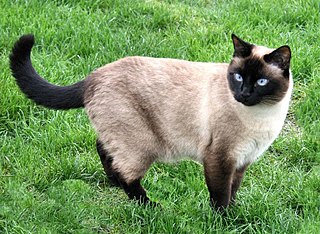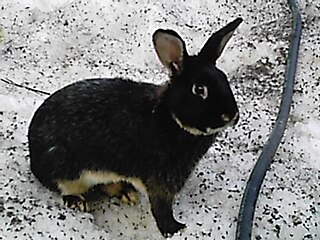The Beveren is one of the oldest and largest breeds of fur rabbits. It was first bred in Beveren, a small town near Antwerp in Belgium. Their coats can be blue, white, black, brown and lilac, though not all of these varieties are ARBA-recognized. There is a rare variety called the Pointed Beveren, which comes in the same colors but has white tipped hairs. The blue variety is the original.
The Beveren rabbit is a rare breed. They are well tempered, clean, and smart. Beverens are full of energy, and love to explore the outdoors. They are recognized by the American Rabbit Breeders Association in three different colors, Black, Blue, and White. The coat should be dense and glossy with a gentle rollback fur type. Fur length is rather long having an average of 1+1⁄4 to 1+1⁄2 inches. This large breed has a pronounced mandolin shape. Senior Bucks weight 8 to 11 pounds and Senior Does weight 9 to 12 pounds (American Rabbit Breeders Association (2016) Standard of Perfection. Bloomington, Il: Author). Their litters are large, the young grow fairly fast, and the does are typically docile and make good mothers.
GENERAL TYPE: 55 points Body: 30 points Head: 10 points Ears: 5 points Feet & Legs: 5 points FUR: 20 points COLOR: 20 points CONDITION: 5 points TOTAL POINTS: 150 points
Juniors and intermediates which exceed maximum weight limits may be shown in higher age classifications. No animal may be shown in a lower age classification than its true age.
30 Points. The body type is to be of mandolin shape. Body is to be medium length, with broad, meaty back and a deep, firm loin. Shoulders are to be strong and firm, with a well-sprung rib cage, tapering slightly from broader, smooth hips. The body should present a definite arch when viewed from the side. The topline is to be a smooth curve, starting at the back of the shoulder, rising to a high point over the middle of the back, and curving over the hips to complete the arch.
10 Points. The head is to be full from top to bottom, with a well-filled face and jaws. Head is to present a distinct curvature between the eyes and nose with a medium broad muzzle. Size of the head is to conform to the body more massive in bucks than in does. A medium dewlap is permissible on does.
10 points. ears are to be well furred and carried in a V-shaped manner. Ideal length is to be 5 or more inches in seniors and intermediates.
5 points. Front feet and legs are to be straight, strong and of medium bone. Hind feet and legs are to be straight, powerful, and well furred. Legs are to be medium bone, in proportion to size of body. In whites, toenails are to be white or flesh colored. In blacks and blues, toenails should be dark.
20 points. The coat is to be very dense and glossy. The guard hairs should be plentiful and of fine diameter, but strong enough to fall or roll gently back into position when stroked from tail to head. Density and texture share equal importance. Ideal fur length is between 1+1⁄4 and 1+1⁄2 inches. (Recommended for showing in breed fur.)
20 Points.
Color is to be deep, glossy, jet black, carried well down into a blue undercolor.
Color is to be a clean shade of light lavender blue, carried well down into the base, free from silvering.
Color is to be pure white, with no ivory cast.
5 Points.

The Angora rabbit, which is one of the oldest types of domestic rabbit, is bred for the long fibers of its coat, known as Angora wool, which are gathered by shearing, combing or plucking. Because rabbits do not possess the same allergy-causing qualities as many other animals, their wool is an important alternative. There are at least 11 distinct breeds of Angora rabbit, four of which are currently recognized by the American Rabbit Breeders Association (ARBA): English Angora, French Angora, Giant Angora and Satin Angora. Others include German Angora, Chinese Angora, Finnish Angora, Japanese Angora, Korean Angora, Russian Angora, St Lucian Angora and Swiss Angora.

Point coloration is animal coat coloration with a pale body and relatively darker extremities, i.e. the face, ears, feet, tail, and scrotum. It is most recognized as the coloration of Siamese and related breeds of cat, but can be found in dogs, rabbits, rats, sheep, guinea pigs and horses as well.

The Netherland Dwarf is a breed of domestic rabbit that originated in the Netherlands. Weighing 1.1–2.5 pounds (0.50–1.13 kg), the Netherland Dwarf is one of the smallest rabbit breeds. Its popularity as a pet or show rabbit may stem from its neotenic appearance. The Netherland Dwarf is recognised by both the American Rabbit Breeders Association (ARBA) and the British Rabbit Council (BRC). The Netherland Dwarf is often confused with the Polish breed of rabbit, but the latter has longer ears, a non-brachycephalic head and less cobbiness.

The Dutch rabbit, also known as Hollander or Brabander, is easily identifiable by its characteristic colour pattern, and was once the most popular of all rabbit breeds. However, after dwarf rabbits were developed, the popularity of the Dutch rabbit dwindled. Nevertheless, the Dutch rabbit remains one of the top ten most popular breeds worldwide.

The Thai Ridgeback is a dog from Thailand. The Thai Ridgeback is one of only three breeds that has a ridge of hair that runs along its back in the opposite direction to the rest of the coat. The other two are the Rhodesian Ridgeback and the Phu Quoc Ridgeback.

The Mini Lop is a breed of domestic rabbit that is recognized by the American Rabbit Breeders Association (ARBA). It is different from the Miniature Lop breed that is recognized by the British Rabbit Council (BRC). The Mini Lop [US] and the Miniature Lop [UK] are different from the Dwarf Lop breed that is recognized by the BRC. The Mini Lop is similar to several other small rabbit breeds, such as the Dwarf rabbit.

Holland Lop is a breed of lop-eared rabbit that was recognized by the American Rabbit Breeders Association (ARBA) in 1979. The Holland Lop, with a maximum weight of 1.8 kg (4 lb), is one of the smallest lop-eared breeds.
Chinchilla rabbits are a group of three rabbit breeds that have been bred for a coat that resembles that of chinchillas. Despite their name, they are not related to and cannot interbreed with chinchillas, which are a species of rodent. Rabbits are lagomorphs. A mutation diluted the yellow pigment in the hairs to almost white, changing in this way the color of the fur of the wild rabbit (agouti) into chinchilla.

Mini Rex is a breed of domestic rabbit that was created in 1984 in Florida by the late Monna Berryhill of Texas. The Rex mutation, derived in France in the 19th century, is recessive and causes the hair to protrude outwards from the body, instead of lying flat, and the guard hairs to be shortened to the length of the undercoat, or a bit longer.

The Silver Marten is a breed of domestic rabbit. Although they are raised to compete in pet shows and agricultural shows, they are also regarded as "loveable and charming" pets.

The Argenté rabbit is one of the oldest breeds of French show rabbits. The British Rabbit Council (BRC) recognises six varieties: Argenté Bleu, Argenté Brun, Argenté Crème, Argenté de Champagne, Argenté Noir, and Argenté St Hubert. The American Rabbit Breeders Association (ARBA) recognises the Champagne d'Argent, the Crème d'Argent and the Argenté Brun. A rare variety, the Argenté Clair, is not currently recognised by either the BRC or ARBA.

The Tri-Colour Dutch is a breed of domestic rabbit created in the Netherlands by crossing tortoiseshell Dutch rabbits with Harlequin rabbits. The Tri-Colour Dutch breed is recognized by the British Rabbit Council but not by the American Rabbit Breeders Association. The coat of the Tri-Colour Dutch is white in the same places as a Dutch rabbit, but the coloured portions of the coat are a mix of orange with either black, blue or chocolate.

The Swedish Hare is a breed of domestic rabbit that resembles a hare and was developed, starting in 2008 in Sweden, for its competitive jumping ability. At the same time but separately, the Elfin breed was being developed in the United States—also in response to the popularity of rabbit show jumping. The Elfin officially became the Swedish Hare in October 2011.
Plush Lop is a breed of domestic rabbit with two varieties: Miniature and Standard. There is also a Canadian Plush Lop breed in development. Similar in appearance, the Velveteen Lop breed is also in development. Miniature Plush Lops were the first to be developed. Devie D'anniballe began creating this breed in 1995 in the United States. She succeeded in developing them by combining the previously existing breeds of Holland Lop, Mini Rex, and Mini Lop. Her aim was to create the perfect pet by retaining the good qualities of these breeds, while "breeding out" all the problems existing in these breeds.

The New Zealand is a breed of rabbit, which despite the name, is American in origin. The breed originated in California, possibly from rabbits imported from New Zealand. New Zealand rabbits are available in five colors recognized by the American Rabbit Breeders' Association (ARBA): white, red, black, blue, and broken. Crossbreeding can result in many other variations, such as gold tipped steel and chestnut agouti. They average 10–12 lb (4.5–5.4 kg) with the does being slightly larger than the bucks. New Zealands are bred for meat, pelts, show, and laboratory uses, being the most commonly used breed of rabbit both for testing and meat production. They are also bred as pet rabbits but mostly breed for meat.

The Harlequin is a colourful breed of rabbit originating from Japan. It is a breed based around the coloration and markings, rather than fur and body type. The ideal weight of a standard Harlequin is 6.5-9.5 lb (2–3 kg), with bucks (males) weighing 6.5-9 lb, and does (females) weighing 7-9.5 lb.

The Himalayan rabbit is a rare medium-sized breed of rabbit easily mistaken for the Californian rabbit. The body is white with colored points, recognized colors are black, blue, chocolate and lilac.

The Mellerud rabbit is a Swedish variety of rabbit of medium size that comes in albino or black with white markings. The Mellerud rabbit has official landrace status in Sweden and is considered a critically endangered variety.